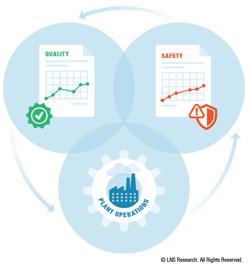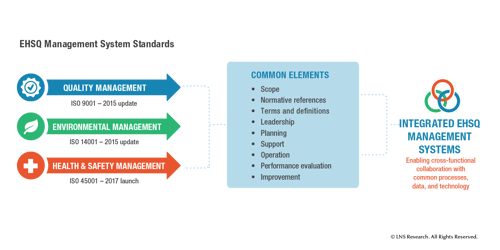The concept of effective integration of environment, health and safety, and quality (EHSQ) management systems has received much attention in the past few years. Though, not surprisingly, the idea of EHSQ integration has not translated into widespread implementation - after all, it’s hard to break down long-standing organization and technology silos, and bring teams, processes, and technology together for the greater good of the organization.
But, several forces have come together to create the opportunity, if not the obligation, for EHS and quality business leaders to look at the possibilities and develop an integration strategy to strengthen both domains and add more value to the business.
The Perfect Storm Driving EHSQ Convergence
 Three industry trends have created fertile ground for organizations to consider further alignment and harmonization of EHSQ management.
Three industry trends have created fertile ground for organizations to consider further alignment and harmonization of EHSQ management.
- The relevant management systems standards (namely ISO 9001, 14001, and 45001) have been harmonized to the same high-level structure.
- Companies increasingly expect their supply chain business partners to conform and certify to these updated cross-industry consensus standards and industry-specific derivatives.
- Organizations in all industries are embracing Industrial Transformation initiatives; digitalization is re-shaping how risk and compliance obligations can and should be managed.
This combination of forces makes it an opportune time for business leaders to take a fresh look at their current approach to EHS and quality management, with the goal of capturing potential synergies from harmonization and integration across people, process, and technology dimensions.
Harmonized Management System Standards Facilitate Integration
Management systems for EHS and quality are widely deployed across industry. They provide the foundational framework of policies, procedures, and processes to achieve organizational objectives and drive continuous improvement in specific disciplines.
Two-thirds of companies report having two or more EHSQ-related management systems in place, with over a third having three or more, albeit in a siloed fashion. This shouldn’t come as a surprise, as the various standards were developed with inconsistent structures, requirements, and terminology. This made it more challenging for organizations to harmonize the implementation of multiple closely-related standards.
 To help companies deal with this divergence, ISO adopted a new high-level structure to harmonize all new and revised standards. It provides a common framework with shared language across all standards, plus the flexibility to add industry- and discipline-specific content. It has ten clauses which include scope, organizational context, leadership, planning, support, operation, performance evaluation, and improvement.
To help companies deal with this divergence, ISO adopted a new high-level structure to harmonize all new and revised standards. It provides a common framework with shared language across all standards, plus the flexibility to add industry- and discipline-specific content. It has ten clauses which include scope, organizational context, leadership, planning, support, operation, performance evaluation, and improvement.
ISO 9001 and 14001 were harmonized in their 2015 updates. ISO 45001:2018 follows the same structure. That means the main EHSQ-related standards share many key elements. It’s now easier for business leaders to integrate discipline-specific management systems, capture synergies from common processes such as risk, audit, incident, and action management, and increase cross-functional collaboration.
5 Questions to Make a Better Integrated Management System Decision
We aren’t advocating the complete integration of EHS and quality management systems, or that even partial integration is necessary in all cases. There is no one-size fits all approach. Such decisions should be made on a case-by-case basis in each organization. Industry sector and the associated risk profile will have a significant influence. We are suggesting that there is potential value from some degree of alignment, harmonization, and integration of management systems, and the teams, processes, and technology that enable them.
The following questions will help business leaders chart the right course for their organization:
- What are the objectives of the existing business functions, how well do the objectives align, and how will changing them impact performance?
- How would an integrated approach impact value and perceived credibility to other functions and top management?
- Can an integrated approach improve organizational culture? Are there cultural risks?
- If the company takes an integrated approach, where would it make sense to start and why?
- Which competencies, processes, and technologies should be managed separately?
Implementing this type of initiative is unlikely to be easy. No organization change initiative is. The potential changes span leadership, teams, processes, and technology impacting many parts of the organization.
The desirability of and benefits from leadership and organizational changes will be unique to each organization and perhaps the trickiest aspect to maneuver through. The process and technology dimensions will likely be more straightforward. Since EHS and quality share many common processes (e.g., risk, audit, incident, action management, etc.), there are likely benefits from process harmonization. Integrating technology is also expected to deliver value, although doing so could be a complex undertaking. Organizations at a technology inflection point and considering implementing or replacing EHS and quality IT systems should consider the combined requirements in selecting a technology partner.
So, is now the time to harmonize and integrate EHS and quality management systems? Maybe. But, definitely it’s the right time to explore the possibilities.